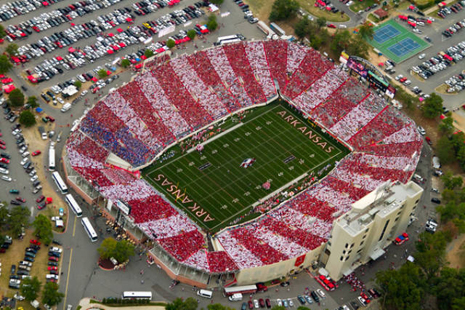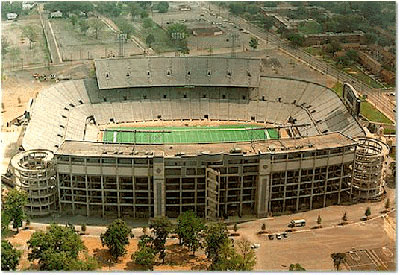
Arkansas fans are right to believe some of their traditions are truly unique. There are, after all, tens of college programs named after Wildcats or Tigers or some permutation of Bear, but there is only one named for the Razorback. And no group of fans, no matter how much they chomp, stomp or damn eagles, has thrown out anything that remotely resembles the Ozarkian eeriness that is the Hog Call. Suiiii generis, indeed.
But in all the recent commotion over Arkansas’ continuing pullout of War Memorial Stadium, I’ve noted a troublesome sentiment that what Arkansas has had all these years in its dual home arrangement has been so wonderfully precious and unique that losing it would present a blow the program may never fully recover from. Not so: plenty other programs split their home games between two stadia for decades. Plenty other fans made memories that lasted a lifetime in the stadium closer to their home. Yes, the other programs stopped doing this. But no, they did not fall apart.
To the contrary, many have thrived since quitting the practice.
These other programs – Oregon, Oregon State, Washington State, Ole Miss, Auburn, Virginia Tech et al – began dual home arrangements for the same, exact reason Arkansas started doing it in Little Rock in 1932: exposure, revenue and what today is called “brand building.” Arkansas leaders knew if their program was ever going to become nationally competitive it needed to have more support from its state, to stop losing the likes of Ken Kavanaugh (Little Rock High grad) to LSU and Don Hutson (Pine Bluff High) and Paul Bryant (Fordyce High) to Alabama. So Arkansas leaders, like leaders at Alabama, Mississippi State and Oregon State, decided to take their team away from its rural campus and parade it in a bigger, in-state city in front of more media and fans.*
Oregon did the same by traveling from Eugene to Portland. Washington State traveled from Pullman to Spokane, while Ole Miss traveled to Jackson and Auburn traveled to Birmingham. Each of the programs pulled out of these metro areas at different times but one overriding reason is the same as in Arkansas’ case – the campus’ stadium simply outgrew the metro area’s stadium. This especially came to the fore in the late 1980s as Auburn jockeyed to stop playing Iron Bowl games in Birmingham, as I wrote in a recent New York Times article: “Auburn leaders increasingly supported moving the game from the 75,000-seat Legion Field to the university’s expanded Jordan-Hare Stadium, which could hold 85,000. Housel [a former Auburn athletic director] said it got to the point that even Auburn fans living in Birmingham were so ready to drive the 120 miles to campus, they would ‘refuse to buy tickets to the Auburn-Alabama game if it was in Birmingham.'”

Every team, as you see in the chart below, has dropped its dual home arrangement in the last 50 years. And programs like Oregon, Virginia Tech, Alabama and Auburn have gone on contend for or win national championships since the drop. Yes, you are right: Arkansas has become unique in the sense that it appears to be the only program that is still hanging on to this practice.
But is that something to be proud of?
It’s better to be proud of winning at a high level, a la Oregon, Auburn and Alabama. But hanging on to War Memorial hasn’t recently helped Arkansas get to this level. Its function was served in helping lift Arkansas to the nationally elite level it enjoyed through much of the 1960s through 1980s. It will not serve in getting Arkansas to the level Jeff Long, Bret Bielema et al expect it to reach in the later 2010s and 2020s.
In the 1930s and 40s, the smartest rural programs traveled 30, 50, 100, 150 miles to the in-state stadia that would give their teams the most bang for their buck in terms of exposure and revenue. In today’s world, where cable television makes distance far less of an obstacle for fans to follow their teams, the smartest programs realize that “neutral site” games in Texas metro sites often provide the best return. Do you think any Notre Dame fans complained in 2009 when their Fighting Irish decided to play Washington State not in Indianapolis but in San Antonio? No, because a) Notre Dame is a national brand and caters to a national audience and b) no program can thrive in today’s competitive recruiting market without spreading its nets as wide as a Texas sunset. If Arkansas wants to be a national powerhouse, wants to sign the best players nationwide and wants nationwide respect, it has to better and more consistently take advantage of its proximity to Texas. That’s why Arkansas has started an annual series with Texas A&M in Arlington. That series, by way of the scheduling complications it could cause if Arkansas were to keep two games in Little Rock, is also a major factor why Jeff Long decided it best to drop War Memorial games to one per year and gain flexibility.
Arkansas is special in that it still clings to a 20th-century business practice long ago abandoned by competitors. That fact in and of itself is nothing to waste a Hog Call on.
* Razorback Stadium had 18,000 seats to War Memorial’s 31,000 when it opened in the late 1940s, according to Mark Ferguson. Razorback Stadium didn’t exceed 30,000 seats until 1957 and didn’t top 40,000 until 1969. War Memorial had already topped 53,000 seats in 1967. By the late 1990s, the stadia were essentially even but a two-year construction project boosted Razorback Stadium to 72,000 by 2001.
Schools other than Arkansas Which Have Had Multiple Home Stadia
Oregon
Home Campus: Eugene
Home Away From Home: Portland
Years Played There: On and off until 1924, then every year through 1966.
Last Game: 1970
Distance Between Homes: 105 miles
Big Win: 21-0 over a UCLA team that would finish 8-2 on Oct. 5, 1957.
Sample Decade: 1952-62: Record of 11-11*
*Includes rivalry games w/ Oregon State
Oregon State
Home Campus: Corvallis
Home Away From Home: Portland
Years Played There: On and off until 1941, then every year through 1973. (w/ exception of two WWII years in which team wasn’t fielded)
Last Game: 1986
Distance Between Homes: 74 miles
Big Win: Oct. 16, 1971- 24-18 over an Arizona State team which would finish 11-1.
Sample Decade: 1963-73: Record of 11-4
Washington State
Home Campus: Pullman
#1 Home Away From Home: Spokane*
Years Played There: 1950-1983
Last Game: 1983
Distance Between Homes: 66 miles
*In 1970, WSU’s home stadium burned due to suspected arson (possibly involving a perpetrator from the rival University of Idaho only eight miles away). As a result, WSU played all its home games in Spokane in 1970 and 1971.
Big Win: Sept. 23, 1978 – 51-26 over an Arizona State team which would finish 51-26.
Sample Decade: 1973-83: Record of 8-12
#2 Home Away From Home: Seattle (the Seattle Seahawks’ stadium, Centurylink Field)
Years Played non-UW opponents there: 2002 through 2008; 2011; 2012-14*
Last Game: Ongoing
Distance Between Homes: 252
Big Win: August 31, 2002 – 31-7 over Nevada to set the tone for a 10-3 season that ended in the Rose Bowl.
Record since 2002 at what’s now Centurylink Field: 6-4
*N.B. the campus of this program’s rival – the University of Washington – is in Seattle. So WSU often plays WU there. Washington State had also played three home games in Seattle against out-of-state powerhouses (USC, Ohio State) in the 1970s. It lost them all.
Ole Miss
Home Campus: Oxford
#1 Home Away From Home: Memphis, TN
Years Played There: 1935-1968 (except for 1943 [WWII] and 1964)
Last Game: 1996
Distance Between Homes: 57 miles
Big Win: Nov. 13, 1965 – Gave Tennessee its only defeated of the season 14-13. The Volunteers finished with an 8-1-2 record.
Sample Decade: 1958-1968: Record of 12-1*
*Includes games with the University of Tennessee and Arkansas.
#2 Home Away From Home: Jackson, MS
Years Played There: On and off until 1964, then 1964 thru 1993*
Last Game: 1996
Distance Between Homes: 146 miles
Big Win: Sept 17, 1977: 20-13 over a Notre Dame team which would finish 11-1.
Sample Decade: 1972-1982: Record of 16-23-1
* Includes annual rivalry game with Mississippi State; In 1973 and 1979, Ole Miss played five games in Jackson and two in Oxford. Also regularly played Southern Miss (with a campus 87 miles away) in Jackson.
Mississippi State University
Home Campus: Starkville
Home Away From Home: Jackson
Years Played There: On and off until 1961, then 1961 through 1990*
Last Game: 1990
Distance Between Homes: 112 miles
Big Win: Nov. 1, 6-3 over an Alabama team which would finish 10-2
Sample Decade: 1975-1985: 18-18
Includes annual rivalry game with Ole Miss; In 1973 and 1979, MSU played five games in Jackson and two in Starkville. Also regularly played Southern Miss (with a campus 87 miles away) in Jackson.
Alabama
Home Campus: Tuscaloosa
#1 Home Away From Home: Birmingham
Years Played There: 1900-2003*
Last Game: 2003
Distance Between Homes: 47 miles
Big Win: Oct. 21, 1989 – 47-30 over a Tennessee team which would finish 11-1.
Sample Decade: 1984-1993: Record of 21-11-1
*Includes annual rivalry game with Auburn and SEC championship games. In 1987, played all home games in Birmingham because of major renovation of home stadium.
#2 Home Away From Home: Montgomery
Years Played There: On and off until 1954 ; Annually 1922 through 1934.
Last Game: 1954
Distance Between Homes: 95 miles
Big Win: Nov. 14,1925: Preserved undefeated season by beating Florida (which would finish 8-2) 34-0.
Sample Decade: 1922-1931: Record of 10-1
Auburn
#1 Home Away From Home: Birmingham
Years Played There: 1904 through 1988
Last Game: 1998
Distance Between Homes: 99 miles
*After 1974, only played rivalry games there with Tennessee and Alabama
Big Win: Sept. 39, 1972 – 10-6 over a Tennessee team which would finish 10-2
Sample Decade: 1967-1975: Record of 10-7
#2 Home Away From Home: Montgomery
Years Played There: 1920-1951
Last Game: 1953
Distance Between Homes: 49 miles
Big Win: Oct. 19, 1935 – 23-0 over a 3-1 Kentucky team
Sample Decade: 1931-1940: Record of 17-3
Virginia Tech
Home Campus: Blacksburg
Home Away From Home: Roanoke
Years Played There: Through 1971; Used almost exclusively as site of rivalry game with Virginia Military Institute until 1936
Last Game: 1971
Distance Between Homes: 26 miles
Big Win: Nov. 30, 1922 – 7-3 over a VMI team which would finish 7-2
Sample Decade: 1936-1947: Record of 4-8-3
*N.B. Other schools played in other home stadia but not – so far as I could find – with the regularity of the above programs. Through the 1950s, for instance, West Virginia often played 120 miles from its home campus in Charleston, W.V., but they only played one game a year there – almost always against rival Washington & Lee. Around the same time Maryland would travel 27 miles to Baltimore to host the likes of Indiana, Duke and Florida, but the Terps never had a long-lasting, annual dual home arrangement in Baltimore.



Do you know what else those others have done that Arkansas fans are so opposed too?? They played other schools in their home state. But I’d be willing to bet your against that too!!
Nope. I would love to see UA play in-state schools. It would on the whole help bring the state together, not divide it.